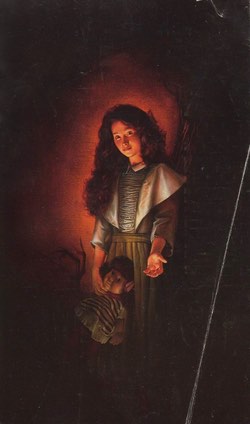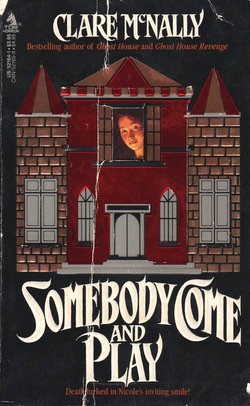Kids: you can’t live with ‘em, you can’t kill ‘em. Whether it’s an unhappy baby that keeps you awake for days until your mind snaps, a demented infant that seems determined to drown you in its own poop, or a toddler who screeches a high-pitched wail until your face explodes, children are the ultimate evil.
In the 70’s and 80’s creepy kids became a mainstay of horror fiction, with one stepback cover of an evil child blurring into another on the racks. John Saul swung between putting kids in peril and making them evil, Ruby Jean Jensen was a one-woman evil baby machine, and Andrew Niederman gave us Brainchild, Child’s Play, Playmates, Teacher’s Pet, and Sister, Sister. Slogging it out down there in the trenches with them was Clare McNally, who wrote about 13 books between 1980 and 1997. Killer kids were an industry because, as Alain Robbe-Grillet once said, “What do little girls dream about? Knives and blood.”
Henry James’s The Turn of the Screw is one of the foundation texts of creepy kid stories, and it knows what its readers want:
“I quite agree—in regard to Griffin’s ghost, or whatever it was—that its appearing first to the little boy, at so tender an age, adds a particular touch. But it’s not the first occurrence of its charming kind that I know to have involved a child. If the child gives the effect another turn of the screw, what do you say to two children—?”
“We say, of course,” somebody exclaimed, “that they give two turns! Also that we want to hear about them.”
I love that “Also.”
Karen J. Renner’s book, Evil Children in Film and Literature, identifies 350 films featuring evil children, with 200 of them produced in the last 15 years. But the tradition goes back way further. Written in 1898, The Turn of the Screw is one of the earliest creepy kid books, but evil children pop up in James M. Cain’s Mildred Pierce (1941) with the snobby Veda, in Ray Bradbury’s 1946 short story “The Small Assassin” about a murderous baby, and in Crooked House, Agatha Christie’s novel featuring Josephine, a 12-year-old psychopath. But the Fifties were the decade when evil kids ruled books.
1950 kicked off with Richard Matheson’s extremely short story “Born of Man and Woman,” then came Jerome Bixby’s classic “It’s a Good Life” in 1953, and 1954 saw the twin towering masterworks of evil kiddie lit: William Golding’s Lord of the Flies and William March’s The Bad Seed. John Wyndham rounded things out with The Midwich Cuckoos in 1957, remade as Village of the Damned in 1960, and for the next ten years evil kids belonged on film.
Turn of the Screw became director and cinematographer Freddie Francis’s dripping, doomed, black and white chiller, The Innocents (1961), Lord of the Flies hit the silver screen in 1963, Jack Hill gave us Ralph, Virginia, and Elizabeth Merrye, three murderous adults with the minds of children in Spider Baby (1964), then came the game-changing Satanic fetus of Rosemary’s Baby, and in 1970 Freddie Francis did it again with Girly (aka Mumsy, Nanny, Sonny & Girly).
The trend kept swinging in the Seventies with Thomas Tryon’s bestseller about evil twins, The Other, and the babysitter torture novel Let’s Go Play at the Adam’s. There was The Little Girl Who Lives Down the Lane (made into a movie starring Jodie Foster), Linda Blair as the ultimate monster/victim in The Exorcist, Larry Cohen’s monster baby of It’s Alive that spawned numerous sequels, and the ultimate evil kids movie, the excellent and chilling Who Can Kill a Child? (1976). But it was another 1976 movie that set the tone for the flood of evil kid movies to come.
The Omen was a trendsetter, inspiring numerous imitators the same way The Exorcist did, and there’s no getting out from under its shadow. The trope it established: a preternaturally mature child, solemn and old-fashioned, possessed by supernatural forces who cause the mysterious, and often gruesome, deaths of everyone who opposes them. If Rosemary’s baby is the infant, then The Omen’s Damien is the child, and Stephen King’s Carrie is the adolescent.
 Like a lot of authors, Clare McNally jumped on this trend and sucked it dry. At first, she was writing haunted house books like Ghost House (1980) and Ghost House Revenge (1981) but by her third book, Ghost Light, she realized that putting kids in peril paid. Her fourth book, What About the Baby? published in 1985 also features an endangered brat, but in 1987 she wrote Somebody Come and Play about a killer ghost girl in the Damien mold, and after that there was no looking back. Spooky kiddies throng Hear the Children Calling (1990), psychic kids populate Cries of the Children (1992), kidnapped kids are in There He Keeps Them Very Well (1994) and The Evil That Christy Knows (1995), and the baby train kept rolling with Goodnight, Sweet Angel (1996).
Like a lot of authors, Clare McNally jumped on this trend and sucked it dry. At first, she was writing haunted house books like Ghost House (1980) and Ghost House Revenge (1981) but by her third book, Ghost Light, she realized that putting kids in peril paid. Her fourth book, What About the Baby? published in 1985 also features an endangered brat, but in 1987 she wrote Somebody Come and Play about a killer ghost girl in the Damien mold, and after that there was no looking back. Spooky kiddies throng Hear the Children Calling (1990), psychic kids populate Cries of the Children (1992), kidnapped kids are in There He Keeps Them Very Well (1994) and The Evil That Christy Knows (1995), and the baby train kept rolling with Goodnight, Sweet Angel (1996).
Somebody Come and Play was published by Tor, and it’s a perfect example of a book that’s loaded with everybody else’s ideas. Set around Lake Solaria, populated by some year rounders and a bunch of summer people, the starting flag is waved when an old lady hangs herself from a tree by a jump rope…or was she pushed? Myrtle, the old woman in question, lives at “the old Hollenbeck place” and I think we can all agree that supernatural crime would plunge if we just tore down every structure termed “the old ____ place.” Myrtle leaves behind no clues except the deadly jump rope, coated in a goopy yellow substance that’s explosive, and a witness in the form of ten-year-old Cassie.
Tough but sensitive cop, Robert Landers, shows up to question Cassie, prompting the ankle-biter to say she’s too tired to possibly answer any questions and she needs a nap. “She’s a witness,” Landers says. “To what?” Cassie’s mom cries. “Some crazy old woman’s suicide?” Compassion flows like a river in this book. But you can’t keep a kid like Cassie down, and soon she’s racing around acting four years younger than her age and hanging out with her BFF’s, Lisa and Diane. But their threesome becomes a foursome when they’re joined by Nicole, a strange old-fashioned and possessive little girl who is ominous and weird because she uses words like “fichu.”
There are all kinds of menaces around Lake Solaria, like Georgie Canfield, a high school drop-out and possible drug dealer who seems to have an unhealthy fixation on Cassie, grabbing her by the arm and snarling, “I’ve been lookin’ at you, girl. You’re growing up, gettin’ real pretty,” before Nicole appears and strangles him. Even worse, the little girls start hanging out at the Old Hollenbeck Place (sigh) because inside is a room full of beautiful toys.
Soon, the detective’s car has caught on fire, he’s sniffing after clues despite robot voices that call to him out of nowhere, saying “Stay away, Detective. The blood of Lake Solaria is mine!” and Cassie’s sink is infested with slugs. One of them turns and looks at her mom and, I swear, we get the following sentence:
It had dozens of needlelike teeth. A sound gargled from its red throat… “Kill-er! Kill-er!”
Meanwhile, the true menace of the Old Hollenbeck Place is revealed when Diane’s little brother, David, sneaks in, looking for the toys. When the little girls entered the toy room, they found a white and pink canopied bed and “Beautiful dolls smiled from the shelves…There were stuffed animals, games, a play kitchen, a dollhouse…” but when David appears he sees, “…action figures in castles and space stations, toy cars, a table hockey game…”
The ultimate horror: gendered toys.
NOOooooooooooooooo…….
Full of incomprehensible sentences (“Cassie’s terrified screams traveled through time…”) and ancient crimes taking place on “orphan trains,” Somebody Come and Play ends with carnage. Cassie’s friend, Diane Morgan, is almost drowned, her brother David is driven insane, and their mother gets her skull pounded to pulp, and Nicole forces Cassie to hide her body. But the book ends on a message of hope because Cassie’s mom gets ASKED OUT ON A DOUBLE DATE!!!!!!!
“It had been dark on Lake Solaria for too many years, and it was time for the sun to shine again.”
Except for those poor, dumb, dead Morgans.
Grady Hendrix has written for publications ranging from Playboy to World Literature Today and his latest novel is Horrorstör, about a haunted Ikea.










